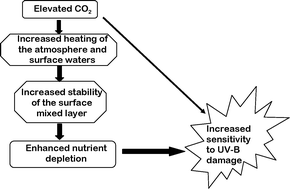It is well known that UV radiation can cause deleterious effects to the physiological performance, growth and species assemblages of marine primary producers. In this review we describe the range of interactions observed between these impacts of ultraviolet radiation (UVR, 280–400 nm) with other environmental factors such as the availability of photosynthetically active radiation (PAR), nutrient status and levels of dissolved CO2, all of which can, in turn, be influenced by global climate change. Thus, increases in CO2 levels can affect the sensitivity of some species to UV-B radiation (UV-B), while others show no such impact on UV-B susceptibility. Both nitrogen- and phosphorus-limitation can have direct interactive effects on the susceptibility of algal cells and communities to UVR, though such effects are somewhat variable. Nutrient depletion can also potentially lead to a dominance of smaller celled species, which may be less able to screen out and are thus likely to be more susceptible to UVR-induced damage. The variability of responses to such interactions can lead to alterations in the species composition of algal assemblages.

You have access to this article
 Please wait while we load your content...
Something went wrong. Try again?
Please wait while we load your content...
Something went wrong. Try again?


 Please wait while we load your content...
Please wait while we load your content...